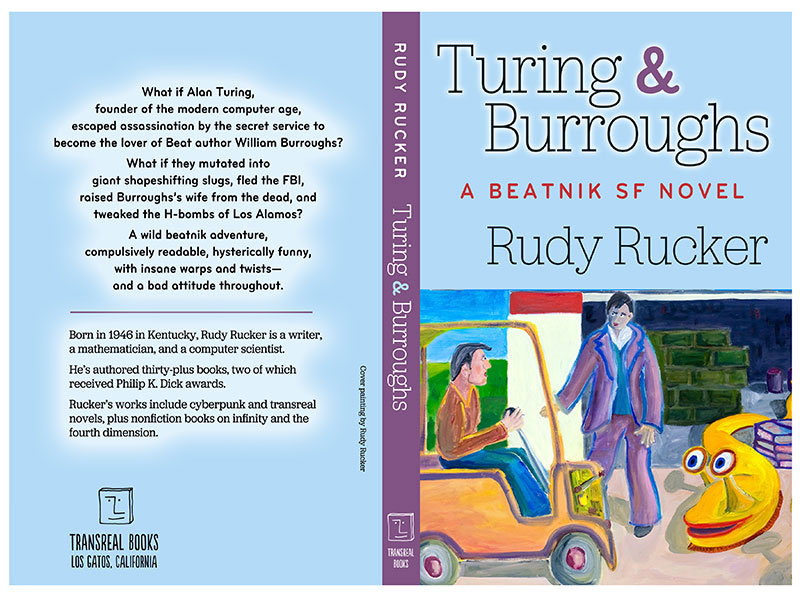Today’s post relates to my new book, Turing & Burroughs: A Beatnik SF Novel. I presented an expanded version of this material as a talk at the Gloucester Writers Center, on August 28, 2012. My “What Is Beatnik SF” rap breaks into four parts:
1: Transreal SF.
2: William Burroughs as an SF Writer.
3: Transreal SF and Beat Writing.
4: Turing & Burroughs: A Beatnik SF Novel.

1: Transreal SF
From 1960 onward I wanted to emulate the closely observed and confessional writing of the Beats, particularly the work of Jack Kerouac and William Burroughs. But I also wanted to be a science-fiction writer, playing with such classic power chords as aliens, robots, higher dimensions, shape-shifting, and intelligent plants.
In 1967-1968, during my senior year at Swarthmore College, the Gloucester writer Gregory Gibson and I were roommates. We both wanted to be writers, we both admired William Burroughs, and we both liked science fiction. We were, you might say, two piglets in the same litter, nuzzling at the same sow.
After college, Greg and I wrote each other frequent letters about our diverging lives—typed letter on pieces of paper. The letter-writing formed my real apprenticeship as a writer. I learned to write with natural cadences and a casual vocabulary.
In 1968, Greg and I tried writing a novel together, mailing sections back and forth. I saw the projected book as a science-fiction novel called The Snake People—about telepathic, wriggling beings that dart through your mind when you’re high. Greg saw the book as a wry slice-of-life description of a young guy’s experiences in the Navy. The main characters were fictional versions of Greg and me. Parts of the draft made me laugh a lot. But we didn’t push The Snake People to a conclusion. We thought we had more important things to do.
I learned something from our experiment. I found that using myself and my friends as characters in a science-fiction novel appealed to me very much. As Greg remarked a little later on, “The cool thing to do would be to write a science-fiction novel, but write it about your actual life.”
And so the model of the Beats—and later the example of Philip K. Dick—led me to a style of writing that I came to call transrealism in my “Transrealist Manifesto.” In my transreal books I use the surreal oddities of SF to illuminate the human psyche.
I like for the characters of my novels to be based on actual people, or on combinations of actual people. The characters should do more than woodenly move the plot along. They should be sarcastic, miss the point, change the subject, break the set, and do surprising things.
It’s liberating to have quirky, unpredictable characters—instead of the impossibly good and bad paper dolls of mass-culture. Lifelike characters are the “real” part of transreal.
As for the “trans” part—I use the special effects and power chords of SF as a way to thicken and intensify the material. The tools of science fiction can be a way, if you will, to directly manipulate the subtext, that is, a way to add a more artistic shape to the suppressed fears and desires that you inevitably incorporate into your fiction.
Time travel, levitation, alternate worlds, aliens, telepathy—they’re all symbols of archetypal modes of experience. Time travel is memory, levitation is enlightenment, alternate worlds are travel, aliens are other people, and telepathy is the fleeting hope of finally being fully understood.
I saw transrealism as a way to describe not only immediate reality, but also the higher reality in which life is embedded. And I saw transrealism as way to smash the oppressive lie of the news-media’s consensus reality.
One of the simplest ways to write a transreal novel is to model the main character on yourself, and I’ve done this numerous times, as in my novels Spacetime Donuts, White Light, The Sex Sphere, The Secret of Life, Saucer Wisdom, and Mathematicians in Love.
But I often write transreal novels without using myself as a character. Not having a specific Rudy-inspired character can give the other characters more space to develop and to open up. And if they’re not me, they can do more shocking things than I have.

2: William Burroughs as an SF Writer
For whatever reason, most people don’t think of William Burroughs’s novel Naked Lunch as science-fiction, but it is. I feel that it’s transreal SF—that is, an autobiographical SF novel in which the author’s experiences are made more vivid by transmuting them into SFictional tropes.
Burroughs often wrote admiringly about SF in his letters, and he sometimes said that’s what he was indeed writing. But people tend to ignore this. Perhaps it’s that so few SF works aspire to such a high literary level, or that Naked Lunch doesn’t have a straight-through plot-line. But if you look at the tropes in the book, it really is SF—aliens, imaginary drugs, telepathy, talking objects … the gang’s all there.
It’s worth mentioning in passing that Jack Kerouac occasionally talked about wanting to write SF as well—although Jack was perhaps too deeply rooted in the pastoral and Romantic mode to write SF. But he liked the idea of SF as a characteristically American literary form, just as jazz is an indigenous American music.
Burroughs’s Yage Letters Redux, edited by Oliver Harris is a kind of epistolary transreal SF novel, featuring exchanges between Burroughs and Allen Ginsberg. Some great lines from Burroughs’s yage letters:
“Yage is space time travel.” “A place where the unknown past and the emergent future meet in a vibrating soundless hum.” “The trees are tremendous, some of them 200 feet tall. Walking under these trees I felt a special silence, a vibrating soundless hum.”
I like the “vibrating soundless hum.” It’s a wonderful image for how telepathy might feel.
The Yage Letters Redux includes Allen Ginsberg’s incredibly heavy letter and journal notes about his own yage trip in Peru seven years after Bill’s. At the start of his trip, Allen is filled with this intense fear of death, a sense that he’s dying right now: “…as if in rehearsal of Last Minute Death my head rolling back and forth on the blanket and finally settling in last position of stillness and hopeless resignation to God knows what Fate…”
Allen writes of beginning “to sense a strange Presence in the hut — or a Being I am blind to habitually — like a science fiction Radiotelepathy Beast from another Universe — but from the series of universes in which I do temporarily exist …”
Ginsberg reaches a core mystical revelation: God/the universe/everything/everyone is a One/Many mind accessible to all, and there is nothing arcane or unusual about this fact, it’s staring us in the face all the time, and there’s no secret, nothing to know, this is all there is, divinity is here and now.
We’re talking metaphysical beatnik SF.
As I recall, Bill’s answer to Allen’s somewhat frantic letter was to mail back some demented sfictional gibberish, and to advice Allen to cut the Burroughs letter into pieces, to paste the pieces onto a sheet of paper and to reread in order to hear Burroughs’s true voice.
Gregory Gibson and I found Burroughs’s response wonderfully amusing, a fine instance of hardcore stoner humor. “Getting a little steep, dude? Enjoy the ride.”

3: Transreal SF and Beat Writing
Let’s look at how some characteristics of beat writing are reflected or contrasted in transreal SF. I’ll set up a series of paragraphs, each with a paired Beat and Transreal SF part.
Beat: A confessional, deeply autobiographical, revelatory style in which no acts or thoughts are kept from view. Transreal SF: A deep autobiographical mode, with the added fillip that by distancing the narrative from conventional reality, the self-exposure is less stark.
Beat: A focus on ecstatic and mystical modes of consciousness, and a turning away from practical political discourse. A focus on personal freedom, and a turning away from any normal kind of working life. Transreal SF: The move to some transcendent higher level is standard for SF, as is a concern with fantastic dilemmas that have little relation to the quotidien daily news. The average SF character has little concern with any conventional career. This is, after all, escape literature.
Beat: Sex and drugs. Transreal SF: The somewhat reactionary mass SF market places limits on the kinds of sex that can be depicted. But if one branches out into indie or underground SF, the sexual possibilities are vast and intense. Regarding intoxication, there are SF novels in which futuristic drugs play a part. But SF also offers possibilities of more outré ways of getting high—for instance via quantum fields, or via telepathic contact with a friend, with an alien, with a physical object, or with the currents in the air.
Beat: Odd language and new, cobbled-together words. Transreal SF: Coining words is standard procedure for SF writers. The trick is to use a poet’s touch in creating the new words. Juicy Ghosts for telepathy, uvvy for universal communication device, bopper for a self-reproducing robot, merge for a powerful body-melting psychedelic, skug for a slug-like mutant, and so on. You want to think about the other words suggested by your made-up word, and choose it so there’s a good match between the said and the unsaid.
Beat: A loose, free style. Most of the books lack any coherent book-length plot or story arc. Transreal SF: SF is at heart a commercial genre. The readers expect a page-turning experience. Although a Beat novel might be something more like a book of poems that one dips into repeatedly over an extended period of time, an SF novel is more typically read at white heat over a period of days.
4: Turing & Burroughs: A Beatnik SF Novel
My novel, Turing & Burroughs, is a beatnik SF novel featuring a 1950s-movie-style “alien invasion,” a love affair between William Burroughs and Alan Turing, and a roadtrip terminating in a thermonuclear blast. My goal was to merge a beat cultural attitude with a page-turning videogame-like plot. Like Kerouac I put my characters onto a road trip and included swatches of travel writing from my journals. Like Burroughs, I used slimy, freaky mutant creatures as a stand-in for the strangeness of the humans who surround us. I wanted to bring Alan Turing into this weird wonderland and to show him a good time.
That’s enough tell, here’s the show: Try browsing the free sample version of my novel that’s currently online as a webpage. Or, perhaps more to the point, look at my early version of the novel’s third chapter, written in the form of letters from Burroughs — this appeared as the story “Tangier Routines” in my webzine Flurb.
Let the beatnik SF word-virus tickle your brain.










September 20th, 2012 at 8:23 am
Maybe I should grow back my goatee and buy some bongos.
September 20th, 2012 at 10:23 am
“Beat: A confessional, deeply autobiographical, revelatory style in which no acts or thoughts are kept from view. Transreal SF: A deep autobiographical mode, with the added fillip that by distancing the narrative from conventional reality, the self-exposure is less stark.”
This also finds a correlative in the “alienation effect,” but on a much more personal level. Both devices allow the reader/viewer (I believe it was Brecht who first coined the term for theater) comfortable distance from one’s own circumstances so that he or she can more objectively view and analyze what’s going on.
September 21st, 2012 at 4:51 pm
EGAD! I truly think this is your best work, Rudy! Thanks for posting!! I am forever your disciple.